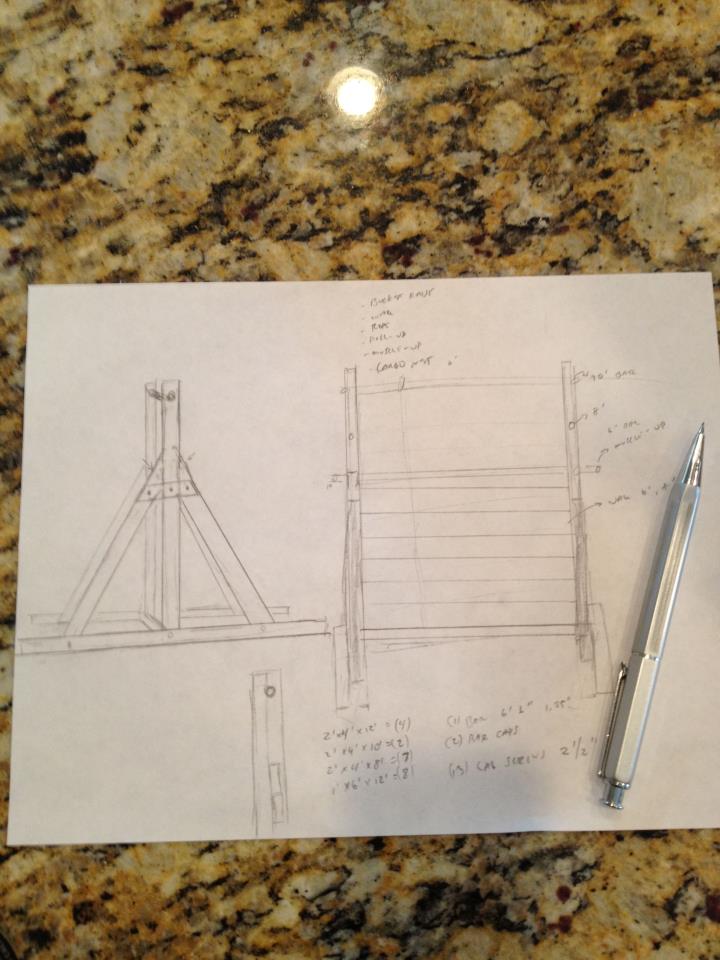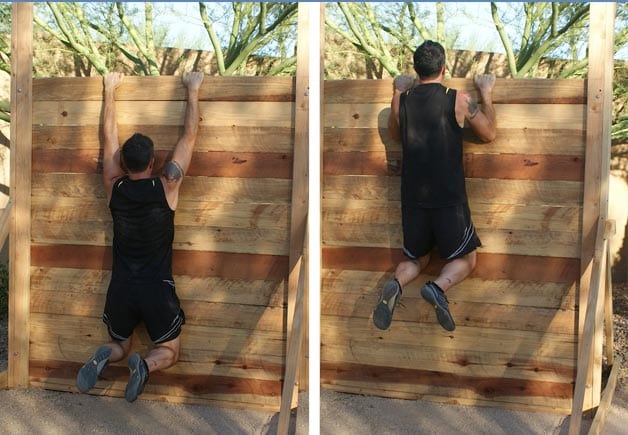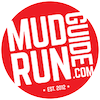In Ultimate Obstacle Race Training, we went into detail about all the different walls you will face at most obstacle races and mud runs. Some are larger than others (Tough Mudder's Everest for example) others are made from interesting materials (like Hadrian's Wall at Victory Quest, made from old tires lashed together) but for the most part walls are exactly a you'd expect: A barrier between you and the rest of the course that you need to scale – by any means necessary – to continue on your quest to finish the event.

Getting over the standard vertical 6 to 8′ wall is covered in You vs. Wall = You Win with photos and even a video tutorial… but that does you just about no good if you don't have a wall to practice & train on!
Disclaimer: This is a general guide, not an exact plan and it's up to you to build a safe wall for yourself or your friends to use. Author makes no claims of safety on or stability of wall during exercises. Build and use any apparatus at your own risk.
The type of wall is completely up to you, but a quick suggestion is to make your modular so you can take it apart to move, make it taller or shorter, or even add a pull-up bar like the one I built for the photo shoot and to test each of the exercises in the program.

The first thing you'll need is a plan, decide on the size of your wall and figure out all the materials you'll need to craft your own training apparatus, jot down a list before you leave for the hardware store or you'll end up wantering the aisles like an idiot… and making 2 or 3 additional trips to pick up the stuff you forgot.
Note: Pick up an extra few studs and lag bolts, you'll end up using them!
Obviously, building your wall extremely sturdy is your first order of business. A 2×4 frame is fine for personal use, provided you support the wall fully and bolt it all together very well before you put any weight on it! Build your OWN wall, use some of the tips below as a guide for how mine came together (and works like a charm) and create your own version. If you make it easy to add cross-members or slats you can keep coming up with new challenges as you get stronger.
For your first wall, simple is probably best; if you've never built anything before or used a saw, then it's a good idea to ask for some help. It's really easy to fabricate a wall, but even easier to cut your fingers off if you have no idea how to use a saw.

Step 1 requires building the base and vertical supports for each side, I chose to use 8′ 2×4's on edge for the base, and (2) 8′ 2×4's bolted together perpendicular to each other for strength and to give my modular wall somewhere to bolt to. (NOTE: 10′ is a great idea to allow for a rope-assisted climbing wall) If you're building a solid wall, you can just bolt the cross-members that make up the wall right to the tical supports. Pay special attention to the way you mount your braces, I cut (2) 2×4's at a 45-degree angle and butted them together on the vertical support, then covered with an additional horizontal brace for stability. My wall is 6′ wide, that proved to be the smallest width possible for climbing the wall and not smashing my feet on the way over. 4′ walls may be cheaper to make, but they are just too narrow!
Knowing that the wall was just for my own training and the photo shoot, I chose to go thin and light for the wall cross-members (the slats that make up the wall) as I knew that I'd have to move the wall multiple times for photos and also wanted to use the apparatus sans-wall for a pull-up & muscle-up bar. I used 1×6 6′ boards to keep it light; if I were to do it over I would've chosen 2×6 planks! You'll notice from the photos (here and in the book) that the wall itself is one unit apart from the supports, I can take it off and raise up and re-bolt easily. (Yes, I had to drill a few extra holes in the supports to make this happen!)
NOTE: With the wall removed I had to add additional supports to strengthen the frame when doing muscle-ups!

Once you have the wall, it's not just about climbing over it! You can use it for strength-building exercises like wall pull-ups that help you develop the upper-body power to pull you up & over all obstacles. Get creative and try out exercises like leg lifts with your hands on the wall, raise a heavy bucket using a rope, or anchor the rope securely and use it to climb up – after you've added some slats to make it an 8 or 10′ wall!
A couple of my favorite drills:
6′ Wall – Tire Toss
Stand on one side of the wall with a tire (or medicine ball, durable sandbag or something that won't break during a 6′ fall). Squat & toss the tire over the wall (or twist & throw – whatever works for you). Immediately jump up, grab the wall and climb over, repeat by tossing the tire back over the wall… continue until you're exhausted.
8′ Wall – Up & Over
Raise the wall up to 8′ (add extra slats, or slide up your modular wall and bolt securely) and stand facing the wall about 3′ away. Set a timer (or use a training partner) for 1:00 to 3:00 minutes, once you hit go, see how many times you can climb over the wall, touch the ground and reverse direction.
10′ Wall – Over By Any Means Necessary!
Raise the wall up to 10′ (did you choose supports that were big enough?) and anchor a rope securely to the ground on the other side. Practice jumping as high as you can, and pulling with one or two tugs on the rop to place one hand on top of the wall and pull yourself over. This will take some practice, but it helps to build explosive power in your upper body to help you master the most difficult obstacles you'll see on race day!
Don't have a copy of Ultimate Obstacle Race Training yet? What are you waiting for!

